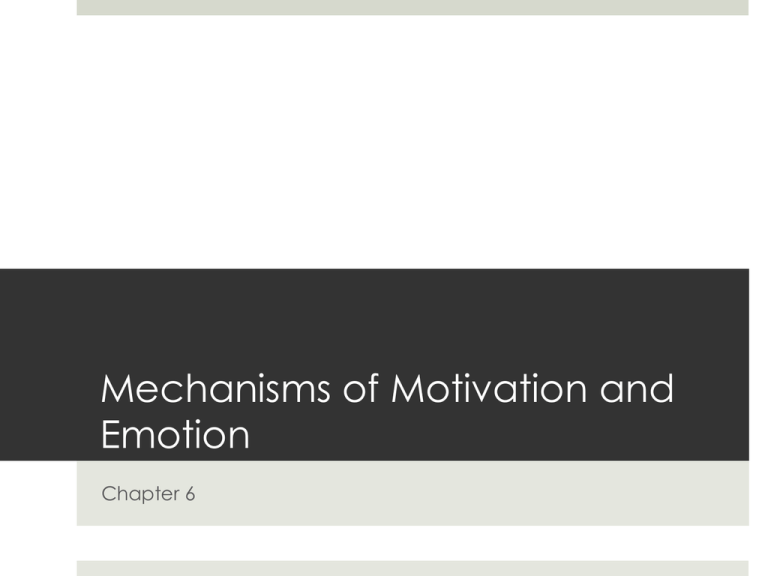
Mechanisms of Motivation and
Emotion
Chapter 6
Principles of Motivation
MOTIVATION: the entire constellation of factors, some
inside the organism and some outside, that cause an
individual to behave in a particular way at a particular
time
DRIVE: or motivational state, an internal, reversible
condition in an individual that orients the individual toward
one or another type of goal
INCENTIVE
DRIVE
HUNGER
Varieties of Drives: Homeostasis
HOMEOSTASIS: the constancy
in the body’s internal
environment that must be
maintained through the
expenditure of energy
Regulatory drives help
maintain homeostasis (hunger,
thirst, sleep)
Nonregulatory drives serve
some other purpose
Nonregulatory Drives
• Fear, anger
• Mating and caring for infants
• Friendship and social acceptance
• Play and exploration
Drives As States of the Brain
CENTRAL-STATE THEORY OF
DRIVES: theory that the most
direct physiological bases
for drives lie in neural activity
in the brain
CENTRAL DRIVE SYSTEM: a
set of neurons in the brain
that, when active, most
directly promotes a specific
drive
Three Components of Reward
Medial forebrain bundle neurons whose
terminals end in the nucleus accumbens
release reward-related neurotransmitters.
Rewards:
1.
Things we like (Endorphins)
2.
Things we want (Dopamine)
3.
Things that serve as reinforcers
(Dopamine and new learning)
Wanting and liking and an element
of surprise (new learning).
Dopamine
Endorphin
Dopamine
Endorphin
Three Components of Reward
Medial forebrain bundle neurons whose
terminals end in the nucleus accumbens
release reward-related neurotransmitters.
Rewards:
1.
Things we like (Endorphins)
2.
Things we want (Dopamine)
3.
Things that serve as reinforcers
(Dopamine and new learning)
Neural and Hormonal Control of
Appetite
Neurons that affect appetite are located
in the ARCUATE NUCLEUS
Appetite-stimulating neurons
NEUROPEPTIDE Y and appetitesuppressing neurons peptide YY (PYY)
Fat cells secrete Leptin acts on hypothalamus
to suppress appetite
Normal vs. Leptin mice
Hormonal Influences on Sex Drive
(all hypothalamic)
Males
The primary hormone
for male sex drive is
testosterone
Testosterone has also
been linked to
aggression,
dominance and
preoccupation with
social status
Females
The primary female hormones
for sexual drive are estrogen
and progesterone
Sexual Differentiation and
Determinants of Sexual Orientation
ACTIVATING EFFECTS have
temporary, reversible effects
Females: XX, Males: XY
“Y” testes male
genitals/brain change
Congenital adrenal
hyperplasia
Identical Twins – 50% heredity
of sexual orientation
DIFFERENTIATING EFFECTS
create long-lasting structural
differences
Fraternal Twins/Siblings – 15%
Male birth order - “maternal
memory” for male gestations
or births. (Blanchard, 2008;
Bogaret, 2006).
Sleep As a Physiological and
Behavioral State
SLEEP is a condition of
relative unresponsiveness
to the environment;
influenced by a
biological clock that
keeps a 24 hour daynight cycle
Dreams and Other Mental Activity
During Sleep
TRUE DREAMS: the person
feels like it is a real experience
and they are sensing the
situation
REM
SLEEP THOUGHT: tend to
involve concerns that
happened during the day
• non-REM
Mammal Trends
Hours
Giant Sloth
20
Opossum, brown bat
19
Giant Armadillo
18
Owl monkey
17
Arctic ground squirrel
16
Tree shrew
15
Cat, golden hamster
14
Mouse, rat, grey wolf
13
The body wears out during the day and sleep is
necessary to restore it to normal functioning
Arctic fox, chinchilla,
gorilla, raccoon
12
Mountain beaver
11
• Large sleeping differences between animals?
Rhesus monkey,
chimpanzee, baboon
9
THE BRAIN MAINTENANCE THEORY OF REM
Human, rabbit, pig
8
Tree hyrax, rock hyrax
5
Cow, goat, elephant,
donkey, sheep
3
Roe deer, horse
2
THE PRESERVATION AND PROTECTION THEORY
Sleep came about in evolution to preserve
energy and protect individuals during that
portion of each 24-hour day when there is
relatively little value and considerable danger in
moving about
E.g. herbivores sleep less than carnivores
THE BODY RESTORATION THEORY
REM sleep provides regular exercise to groups
of neurons in the brain and preserves important
neural circuits (Infants vs. Adults)
Individual Variation in the Sleep Drive
NONSOMNIACS need
much less sleep than
average and still function
normally the next day
INSOMNIACS have a
normal sleep drive but, for
whatever reason, sleep
much less than they would
like
Brain Mechanisms of the Daily
Sleep Cycle
CIRCADIAN RHYTHM: any cyclic physiological or behavioral
change in a living thing that has a period of about 1 day even
in the absence of external cues signaling the time of day
Suprachiasmatic nucleus (rhythm-generating neurons)
Body temperature
Melatonin
• Activates sleep
• Lesions in this area cause permanent sleeplessness
• Release OREXINS
• Leading cause of narcolepsy
The Nature and Value of
Emotions
EMOTION: a subjective
feeling that is experienced as
directed toward some
particular object or event
AFFECT: any emotional
feeling
MOOD: a free-floating
emotional feeling, not
directed at a specific object
Plutchik’s Model of Primary Emotions
Effects of Bodily Responses on
Emotional Feelings
Emotions are accompanied by peripheral changes
Heart rate, blood pressure, diversion of blood, gland activation,
muscle tension, facial expressions
Common sense dictates that our emotions cause these
changes…but what if it’s the other way around?
Theories of Emotion
The bodily reaction to an emotion-provoking stimulus is
automatic, occurring without thought or feeling at first, and the
assessment of one’s emotional state comes later
Emotional state depends on the sensory feedback pertaining to the
body’s response as well as the person’s perceptions and thoughts
about the environmental event that provoked the response
The Facial Feedback Theory of
Emotion
Sensory feedback from facial expressions contributes
both to emotional feelings and to the production of the
full-body reactions that accompany emotions
Brain Mechanisms of Emotion
The AMYGDALA is the
brain’s early warning
system
Receives sensory input
from:
A fast subcortical route
A slower cortical route
The PREFRONTAL CORTEX
is essential for conscious
experience of emotions





